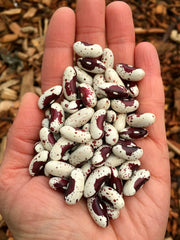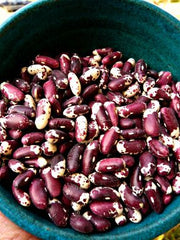Bean, Bush Dry, 'Jacob's Cattle'
*Ark of Taste Heirloom*
(P. vulgaris) A legendary northeast variety that has been shown for centuries to thrive in tough northern climates. Local stories claim this Prince Edward Island heirloom to have been a gift from the Passamaquoddy tribe to Joseph Clark, the first white child born in Lubec, ME. The rest of its legend comes from kitchens across northern New England, where it is known to make a fierce pot of baked beans. Excellent as a shelling bean (harvest in plump, not dried stage), the fully dried white and maroon speckled kidney-shaped beans hold up well to long cooking. Early and prolific in the field. Tried and true.
80 days. UO
Packet: 1oz (~60-70 seeds)
Availability: In stock
Growing Info
SOWING:
Direct seed after the last frost date when the soil has warmed.
Note: Beans prefer well-drained, warm soil.
PLANTING DEPTH:
1"
SPACING:
3-5" between plants with 12-24" between rows*
*Pole beans require 5+' between rows.
EMERGENCE:
5-10 days @ soil temp 65-90F
LIGHT:
Full sun to part shade
FERTILITY:
Light to Moderate. Beans can produce their own usable nitrogen from atmospheric nitrogen through a symbiotic relationship with bacteria that colonize specialized nodules in their roots. Too much soil fertility can cause excessive vegetative growth at the expense of pod set and maturity.
Beans prefer well-drained warm soil with a pH between 6.0-7.0.
ADDITIONAL NOTES:
Beans prefer warm soils and may rot at lower temperatures. This is particularly true for white-seeded varieties. You love beans. Patience.
It can be quite beneficial to mix bean seeds with commercially available bacterial "inoculants" to encourage the beneficial symbiotic relationship in the growing plant's root nodules, especially if growing on ground that hasn't been planted with beans before. This can increase yields and improve plant health.
Avoid picking/weeding beans when the plants are wet. This will help prevent the spread of disease.
Provide a trellis for pole beans.
White-seeded varieties are more susceptible to rot when seeded in cool, wet, early-season conditions.
Sow Snap Beans every few weeks for continued harvests.
Harvest dry beans when the pods are brown and dry.




